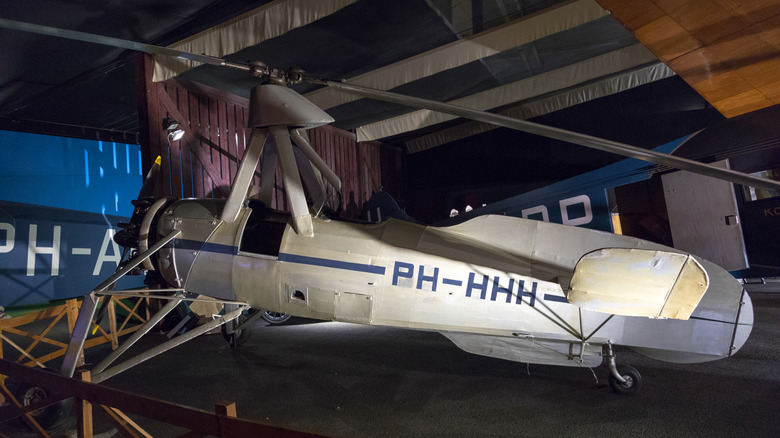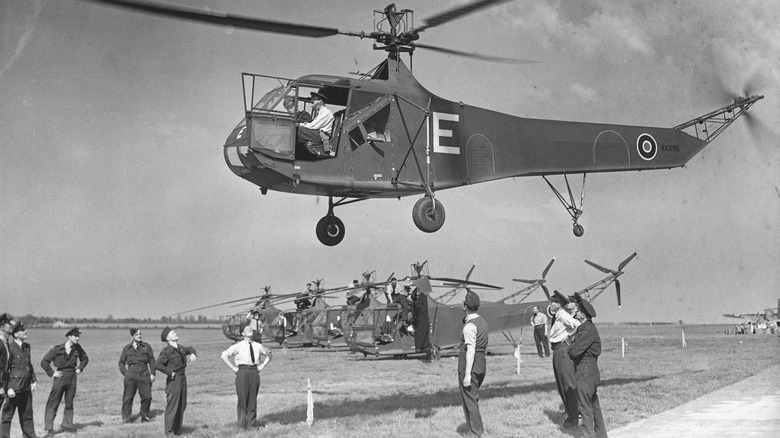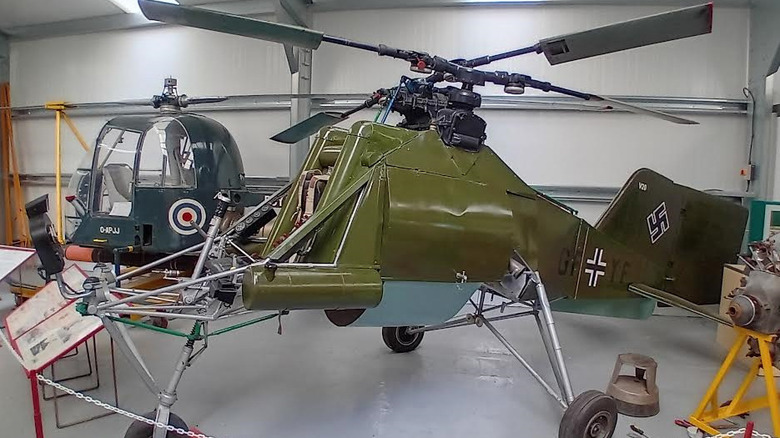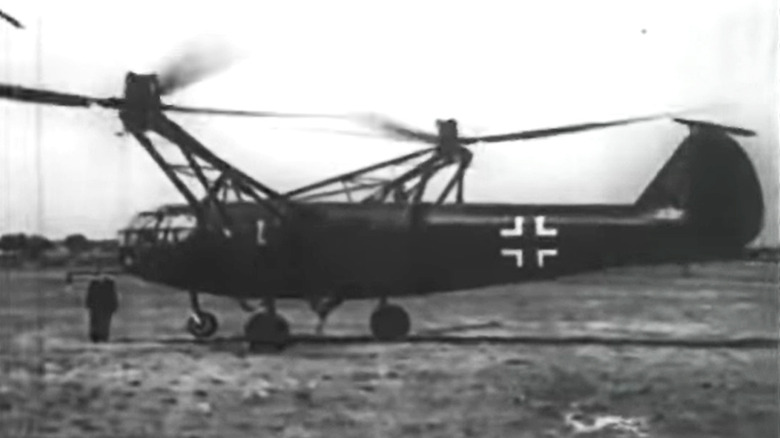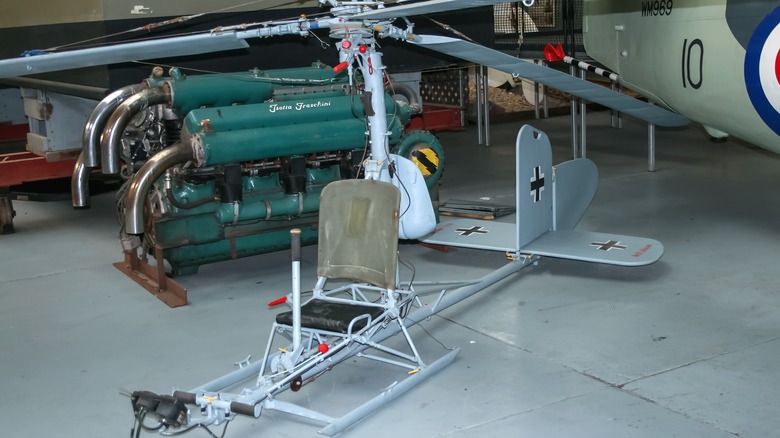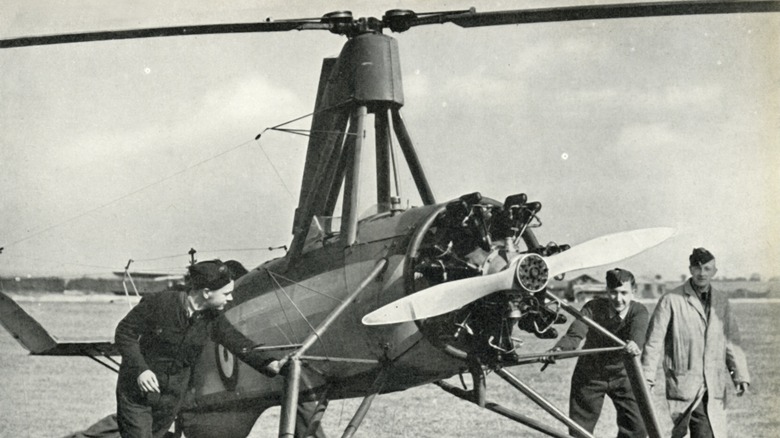5 Little-Known Military Helicopters Used In WW2
The introduction of the helicopter changed how armies operate. This multi-role aircraft can be a potent offensive weapon, an efficient transport method, a crucial medevac resource, and a versatile reconnaissance platform — to name a few. The first major conflict to feature helicopters was the Korean War, a role that was immortalized in the M.A.S.H film and TV series. Of course, the part played by helicopters in the Vietnam War also ensured that the craft's place in military doctrine and public perception was cemented. However, while the Korean War could be considered the conflict where the helicopter cut its teeth and the Vietnam War may be viewed as when it reached its turbulent teenage years, the history of the helicopter in warfare stretches back further than this.
In fact, the first helicopters to take part in combat operations did so in World War II. The Sikorsky YR-4B "hoverfly" was the first craft to have the honor of flying combat missions for the U.S. military. It took part in its first operation in May 1944. After the mission, Colonel Philip Cochran — commanding officer of the 1st Air Commando Group — wrote, "Today the 'egg-beater' went into action and the damn thing acted like it had good sense." However, the Sikorsky YR-4B wasn't the only helicopter to make its debut in World War 2. Let's take a closer look at the Sikorsky R-4B and some of the other little-known helicopters that laid the foundations for a warfare revolution and hi-tech machines like the Apache attack helicopter.
The Sikorsky YR-4B Hoverfly
When Second-Lieutenant Carter Harman flew the first combat mission of a Sikorsky YR-4B helicopter, he probably wasn't aware that he was flying into the pages of history. Initially, the helicopter was expected to play more of a backroom role, shuffling parts and other logistic tasks. However, this changed when it was called on to rescue an American pilot and three injured British soldiers from a crash site in a paddy field in Burma (now known as Myanmar). This wasn't an "ease you into it" type of mission, either.
First, the helicopter was over 500 miles from where the men were trapped, and in between them, there was the trifling matter of a 5,000-foot mountain range. All this had to be negotiated in a craft with a ceiling of 8,000 feet, a 200 hp engine, and a top speed of 75 mph, with a range of 130 miles. It's also worth noting that structurally, this primitive helicopter was built around steel tubing and wooden stringers covered with fabric and thin sheets of aluminum or magnesium alloy.
But Lt. Carman and his trusty steed made the journey and over the course of four missions (the helicopter only had room for one passenger) were able to rescue the men from the dense jungle. This is despite the engine seizing (twice) and coming under enemy fire. It was the first medevac mission undertaken by a helicopter, and it set a template for what was to become one of the aircraft's defining military — and civilian — roles.
Flettner Fl 282 Kolibri
The Flettner Kolibri made its first flight in 1941 and quickly captured the interest of the Kriegsmarine. The helicopter had some design features and capabilities that made it the perfect choice for naval operations, as it could be launched from German naval ships. It is worth remembering that the Graf Zeppelin, the German Navy's only aircraft carrier, although launched in 1938, never saw active service. While a helicopter could never fill the offensive role of a squadron of carrier-launched planes, from 1942 it played a critical role in Anti-Submarine warfare operations. The helicopters were used as airborne scouts helping to guide naval vessels towards submerged allied submarines.
The aircraft wasn't restricted to naval operations either, a formation of five Flettner Fl 282s made history during the Battle of the Bulge when a modified B2 variant of the craft conducted the first helicopter attack against armor. The attack destroyed two American tanks and two of the attacking helicopters were also destroyed in the operation. From an engineering standpoint, the Flettner used intermeshing rotors (two rotors that turn in opposite directions), which negated the need for a tail rotor.
This design concept carried on after the war when Anton Flettner moved to the US and was recruited to head the design department at Kaman Aircraft. A point that goes a long way to explaining why Kaman became the only American firm to ever mass-produce intermeshing rotor helicopters. Check out SlashGear's guide on how Kaman's modern K-Max helicopters use intermeshing rotors for an in-depth explanation on this rotor configuration.
Focke-Achgelis Fa 223 Drache
If you're asked to name a helicopter with dual main rotors the chances are you will pick the Sikorsky Chinook, one of the most iconic military helicopters of all time. However, the concept of such an aircraft (albeit with a different rotor configuration) has been around for far longer than the Chinook. The Focke-Achgelis Fa 223 Drache is an early example of this in action. Designed by Henrich Focke of Focke-Wulf fame, the Fa-223 Drache (Dragon) was the first helicopter in the world to reach production status. However, only about 20 of these ever made it off the production line, the numbers being limited due to allied action rather than a lack of enthusiasm. Incidentally, Focke-Wulf also produced the Fw190, one of the best German fighter planes of WWII.
The Drache boasts some impressive performance figures that suggest this could have been a useful addition to the German armed forces had production numbers enabled it. Powered by a single 1,000 hp BMW Bramo engine, the helicopter boasted a top speed of 113 mph, a ceiling of 23,300 feet, and the capability to lift loads of 2,200 pounds.
As far as combat history, the helicopter had little to shout about, largely this is down to the Allies winning the continual game of "hide and seek" that saw them destroy the various production facilities tasked with building the machine. However, it did end the war on a more glorious note when a captured Fa 223 Drache became the first helicopter to successfully cross the English Channel.
Focke-Acheglis Fa 330 Bachstelze
From a twin-rotor helicopter capable of carrying a couple of tons, to an unpowered "helicopter glider" even in the early days of helicopter development, it's clear that military planners were already exploring the helicopter's versatility. The Fa-330 Bachstelze (Wagtail in English) is perhaps one of the most unusual uses of the fledgling technology. The Fa-330 was designed as a surveillance platform and had a horsepower rating of — well, zero, thanks to a lack of engine. The craft was designed to be towed behind German U-boats to allow lookouts to see further than was otherwise possible in a low-profile submarine (about 33 miles). Of course, the downside of this is it also gave away the location of the submarine and this made it unpopular with U-boat commanders.
The Fa-330's tow cable allowed the helicopter to reach a maximum height of 722 feet (220 meters). A communication line also ran along the tow cable, this allowed the pilot to report directly to the U-boat crew. When not in use, the craft was stored in two waterproof compartments situated in the U-boat's conning tower. Ultimately, the helicopter was of limited use. Allied naval superiority in the Atlantic Ocean made surfacing in daylight too dangerous for German submarines and even more so when their presence was advertised by towing a large kite. This is why the Fa-330 only saw action in boats operating in the Southern Atlantic and Indian Ocean.
Avro 671 - AKA the Cierva C30A
The Avro 671 is another early adopter of the "gyrocopter" version of the helicopter. However, unlike the Fa-330, the Avro 671 was able to fly under its own power. The helicopter was essentially a "rebadging" of the Cierva C30A developed by the British-based Spanish engineer Juan de la Cierva and built under license by Avro. The helicopter was initially considered by the RAF as a potential observation and communication platform. With this in mind they ordered a few for evaluation purposes. However, in the end, the powers that be decided that the craft was unsuitable for the role. Instead, the helicopter's ability to fly slowly saw it being used to help calibrate another emerging technology — the U.K.'s radar network.
The Avro version of the helicopter was powered by a seven-cylinder Armstrong Siddeley radial engine that produced 140 hp. In total, 143 of these were built, making it the most produced of any pre-war helicopter. Interestingly, Henrich Focke also bought production licenses for the forerunner of the C30, the C19, and then latterly the C30 itself. He studied the design characteristics of these craft intensively and used the lessons he learned to help develop a fully operational helicopter. Sadly, Juan de la Cierva was killed in an air crash at Croydon airport on December 9, 1936, and one of the pioneering figures of helicopters was lost to the worst air crash in the UK at that time.
